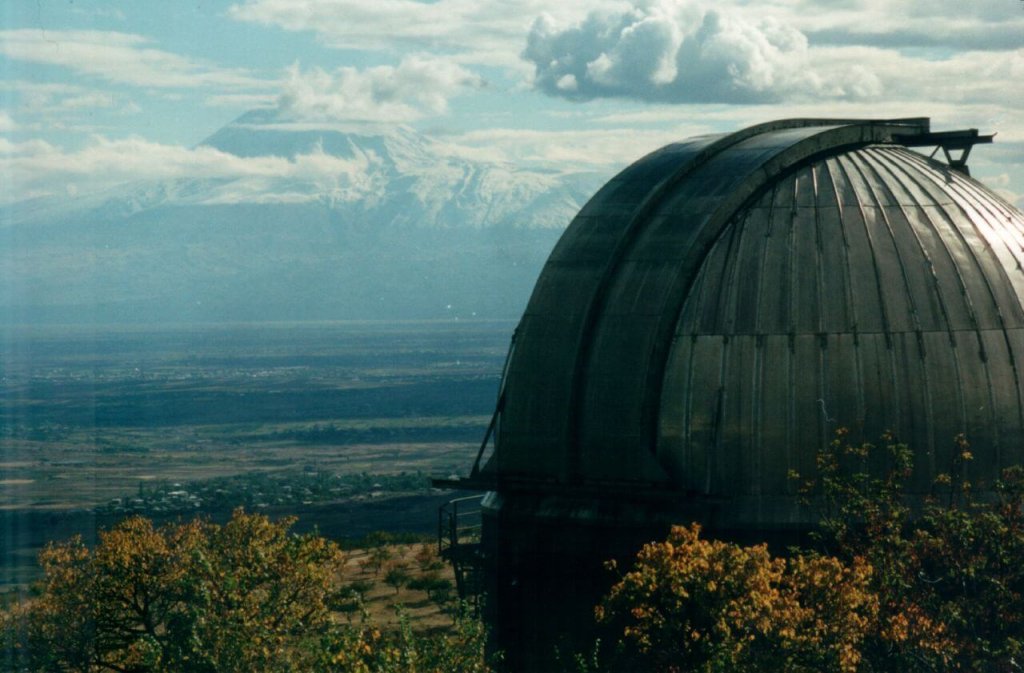The Byurakan Astrophysical Observatory (BAO) is one of Armenia’s most important science centers. Founded in 1946 on the southern slope of Mount Aragats near Byurakan village, it’s known worldwide for its contributions to astronomy and space research. Recognized by the Armenian government as a “National Value,” Byurakan Observatory continues to be a major center for scientific discovery.

History of Byurakan Observatory
The Byurakan Observatory was founded in 1946 by Viktor Hambartsumyan, a well-known Armenian scientist. Hambartsumyan was born in Tiflis (now Tbilisi) in 1908 and showed great talent in math and science from a young age, thanks to his father’s encouragement. After completing his studies, he became a professor at Leningrad University, where he started the Soviet Union’s first Department of Astrophysics.
When Hambartsumyan moved to Armenia, he helped create the Academy of Sciences of the Armenian SSR and served as its leader. In 1946, he founded Byurakan Observatory, which would soon become a leading astronomy center in the Soviet Union. His research laid the foundation for many areas of modern astrophysics, including the study of stars and galaxies.
Scientific Contributions and Research
Byurakan Observatory has made many important contributions to astronomy, with some of its best-known projects including:
Markarian Survey: Led by Armenian astronomer Benjamin Markarian, this study, known as the First Byurakan Survey, found a special type of galaxy with bright centers. These galaxies, known as “Markarian galaxies,” helped scientists better understand how galaxies are formed.
Star Formation Research: Hambartsumyan’s team studied how stars are born and showed that galaxies release large amounts of energy when their centers are active. They also suggested that stars and star systems are created from dense materials in galaxy centers.
Current Research: Today, Byurakan Observatory continues to work on new research projects and frequently collaborates with international science organizations. Many of the observatory’s scientists are members of the International Astronomical Union (IAU) and contribute to research published around the world.
Facilities and Equipment

Byurakan Observatory is equipped with powerful telescopes and other specialized tools. One of its most famous instruments is the 1m Schmidt Telescope, installed in 1960. This large telescope has helped the observatory observe large areas of the sky, finding stars, galaxies, and other objects.
The observatory’s location on Mount Aragats allows for clear views of the night sky with less atmospheric interference, which is ideal for astronomical observations. The observatory itself is also architecturally unique and has been proposed as a “Unique Astronomical Heritage” site by the IAU.
Visitor Information and Events
Byurakan Observatory welcomes visitors and offers tours, events, and stargazing opportunities. Here’s how you can explore the observatory:
Guided Tours: The observatory offers tours that showcase its history, research, and telescopes. Visitors can learn about the observatory’s work and its place in Armenian science.
Public Events: Byurakan Observatory hosts stargazing events and educational programs. With its remote location and clear skies, the observatory is a popular destination for stargazing enthusiasts.
The best time to visit BAO is during clear weather, which offers the best visibility for observing the night sky. Tour schedules and event details are usually available through the observatory or the National Academy of Sciences.
Byurakan Observatory’s Role in Armenia
Byurakan Observatory has an important place in Armenian science and culture. It was recognized as a “National Value” in 2013, along with the Matenadaran and the Armenian Genocide Museum-Institute. Its unique architecture and scientific value have made it a landmark in Armenia.
For over 50 years, the observatory has hosted International Astronomical Union conferences and worked with science organizations around the world. Many of its scientists are part of international academic journals, bringing recognition to Armenian science on the global stage.
Conclusion
Byurakan Observatory is not only Armenia’s main astronomy center but also a symbol of the country’s commitment to science. From its founding by Viktor Hambartsumyan to its ongoing research, the observatory continues to be a center of discovery. Visiting Byurakan Observatory offers a unique chance to connect with Armenia’s scientific heritage and experience the wonders of the universe.
Frequently Asked Questions about Byurakan Observatory
Who founded Byurakan Observatory?
Byurakan Observatory was founded by Viktor Hambartsumyan in 1946. He is known as one of Armenia’s most important scientists and made major contributions to the study of space.
What is the Markarian Survey?
The Markarian Survey, also called the First Byurakan Survey, discovered active galaxies with bright centers, which scientists still refer to as “Markarian galaxies.”
Can the public visit Byurakan Observatory?
Yes, Byurakan Observatory offers guided tours, public stargazing nights, and educational programs for visitors interested in Armenian astronomy.
What is special about Byurakan Observatory’s 1m Schmidt Telescope?
The 1m Schmidt Telescope, installed in 1960, is one of the largest telescopes of its type and plays an essential role in Byurakan’s research.
Why is Byurakan Observatory considered a “National Value” in Armenia?
In 2013, Byurakan Observatory was named a “National Value” for its scientific contributions and its role in Armenian culture, alongside other landmarks like the Matenadaran.




